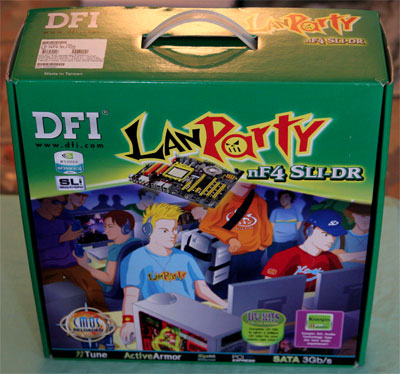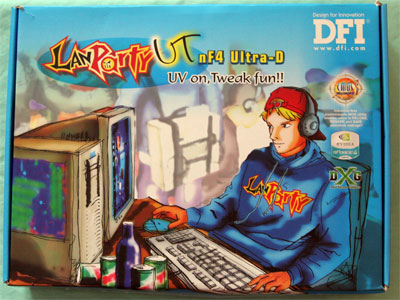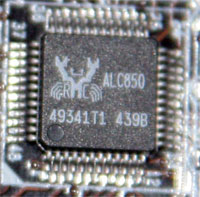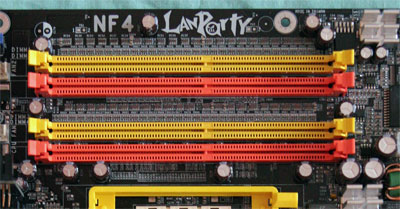DFI nForce4: SLI and Ultra for Mad Overclockers
by Wesley Fink on February 5, 2005 9:30 AM EST- Posted in
- Motherboards
Basic Features: DFI nForce4
DFI uses the same PCB for all nForce4 models. This assures that the overclocking capabilities of all the nForce4 boards are the same. In fact, all boards use the same BIOS. The 3 DFI nForce4 models are:- LANParty nF4 SLI-DR
- LANParty UT nF4 SLI-D
- LANParty UT nF4 Ultra-D
Models with the SLI name feature the nVidia nForce4 SLI chipset, while those with Ultra use the nF4 Ultra chipset. All boards feature dual PCIe slots, and the "R" in the SLI-DR adds Silicon Image 3114 4-drive SATA RAID. The two LANParty UT models are identical except one uses the SLI Chipset and the other uses nF4 Ultra.

We tested production models of the top and bottom of the DFI nForce4 lineup, and we can report that performance of these two models was exactly the same in all our benchmarks. Your choice, therefore, should be based on the SLI/Ultra choice and other features. In addition, those who are willing to mod a chip can make a minor change to the $140 Ultra-D board and convert it into an SLI chipset with SLI performance identical to the top line SLI boards. Details on this mod are available at Morphing nForce4 Ultra into nForce4 SLI.
| Specification | DFI LANParty nF4 SLI-DR | DFI LANParty UT nF4 Ultra-D |
| CPU Interface | Socket 939 Athlon 64 | |
| Chipset | nForce4 SLI (single chip) | nForce4 Ultra (single chip) |
| Bus Speeds | 200MHz to 456MHz (in 1MHz increments) | |
| PCI/AGP Speeds | Asynchronous (Fixed) | |
| PCI Express | 100MHz to 145MHz in 1MHz increments | |
| Core Voltage | Auto, 0.8V to 1.55V in 0.025V increments (Normal) PLUS *104%, 110%, 113%, 123%, 126%, 133%, 136% (Special - to 2.1V) |
|
| CPU Startup Voltage | Startup, 0.825V to 1.550V in 0.025V increments | |
| DRAM Voltage | 2.5V to 3.2V in 0.1V increments (3V jumper) 2.5V to 4.0V in 0.1V increments (5V jumper) |
|
| Chipset Voltage | 1.5V, 1.6V, 1.7V, 1.8V | |
| Hyper Transport Ratios | Auto, 1.0, 1.5, 2.0, 2.5, 3.0, 4.0, 5.0 | |
| LDT Bus Transter | 16/16, 16/8, 8/16, 8/8 | |
| LDT Voltage | 1.2V, 1.3V, 1.4V, 1.5V | |
| CPU Ratios | Auto, 4x to 25x in 0.5x increments | |
| Cool'n'Quiet MAX FID | Auto, 8.0 to 13.0 in 0.5x increments | |
| DRAM Speeds | Auto, 100, 120, 133, 140, 150, 166, 180, 200 | |
| Memory Command Rate | Auto, 1T, 2T | |
| Memory Slots | Four 184-pin DDR Dual-Channel Slots Unbuffered ECC or non-ECC Memory to 4GB Total |
|
| Expansion Slots | 2 x16 PCIe Slots 1 x4 PCIe 1 x1 PCIe 2 PCI Slots |
|
| Onboard SATA | 4-Drive SATA by nF4 PLUS 4-Drive SATA by Sil31144-Drive SATA by nF4 |
|
| Onboard IDE | Two Standard nVidia ATA133/100/66 (4 drives) | |
| SATA/IDE RAID | 4-Drive SATA PLUS 4-Drive IDE (8 total) Can be combined in RAID 0, 1 PLUS 4-Drive SATA by Sil3114 Sil3114 Raid 0, 1, 5 |
4-Drive SATA PLUS 4-Drive IDE (8 total) Can be combined in RAID 0, 1 |
| Onboard USB 2.0 IEEE-1394 | 10 USB 2.0 ports supported nF4 2 1394A FireWire ports by VIA VT6307 |
|
| Onboard LAN | Dual Gigabit Ethernet PCIe by Vitesse VSC8201 PHY PCI by Marvel 88E8001 |
|
| Onboard Audio | Karajan Audio Module based on Realtek ALC850 8-Channel codec with 6 UAJ audio jacks, CD-in, front audio, and coaxial SPDIF In and Out |
|
| Other Features | Power and Reset momentary switches | |
| BIOS | Award 2/01/2005 | |
All of the new DFI boards are based on either the nForce4 SLI or the nForce4 Ultra. More information on nForce4 is available at:
Morphing nForce4 Ultra into nForce4 SLI
NVIDIA's GeForce 6 SLI: Demolishing Performance Barriers
FIRST LOOK: Gigabyte K8NXP-SLI
FIRST LOOK - nForce4: Gigabyte K8NXP-9
nForce4: PCI Express and SLI for Athlon 64
NVIDIA SLI Performance Preview with MSI's nForce4 SLI Motherboard
The DFI boards all support the full range of nVidia nForce4 features including nVRAID, Active Armor, SATAII 3Gb/s drives, NCQ, any-drive IDE/SATA Raid, PCIe Gigabit LAN by a PHY Ethernet chip (plus an additional PCI Gigabit LAN), and the nTune utility.
Packaging for the full LANParty nF4 SLI-DR is typical LANParty.

It is a huge package with a motherboard, UV cables, a system carrier, a Front-X box, and even UV sheathing for your system cables.
The UT provides a more modest package.

The UT does include most of the same features and accessories found in the LANParty SLI-DR, however. The board is the same except it is based on the Ultra chipset instead of SLI and the Ultra-D does not have the additional 4 SATA ports provided by the Silicon Image 3114. You still get the UV cables, and even the same Karajan Audio Module. The missing accessories are the system carrier, Front-X (which will be very important to some) and cable sheathing. If performance is what matters to you, then you can choose any of the new DFI nForce4 boards and then decide what additional features and accessories matter to you.
DFI has continued with the Karajan Audio Module first introduced on their LANP arty 925x. However, we wish that DFI had been able to use the High Definition ALC880 or a similar chip instead of the more common ALC850. The Karajan Module isolates audio for best signal-to-noise ratio and high definition chip benefits most from this isolation.

The Realtek ALC850 7.1 audio chip has appeared on many recent motherboards. This 8-channel audio codec is fully AC '97 2.3 compliant and features 16-bit 8-channel audio and auto-jack sensing with support for a full range of analog and digital IO. The Karajan Module includes both SPDIF in and out coaxial connectors on the rear IO panel. There is also an on-board SPDIF connector for an optical cable.
The ALC850 Codec provides four pairs of stereo outputs, with 5-Bit volume controls and multiple stereo and mono inputs, along with flexible mixing, and gain and mute functions. Two 50mW/20ohm headset audio amplifiers are integrated at Front-Out and Surround-Out, and both amplifiers are selectable for Front-Out, Line-In and Mic-In as a Universal Audio Jack.
You can find more information on the recently released ALC850 atRealtek.

DFI provides a full selection of rear I/O ports. These include 6 programmable audio mini jacks plus coaxial SPDIF in and out connectors to support the Realtek ALC850. The back panel also includes PS2 mouse and keyboard, 1 standard Firewire (IEEE1394a), 6 USB, and two RJ45 Gigabit Ethernet. There are no rear ports for a Parallel Printer or serial devices, but there is an onboard header for an external serial device - an IR header.

On "R" models, like the DFI LANParty nF4 SLI-DR, DFI uses the Silicon Image 3114 SATA controller to add 4 more SATA ports to the 4 already provided by the nVidia nForce4 chipset. The Sil3114 ports can be combined in RAID 0, 1, or 5. RAID 5 can be implemented on this controller with 3 hard drives.

The four DIMM slots support up to 4GB of up to DDR400 memory in a Dual-Channel memory configuration. Dual-Channel 1 is DIMMs 1 and 3, and Dual-Channel 2 is DIMMs 2 and 4. DFI specifies support for both ECC and non-ECC unbuffered memory. Contacts at DFI advise that best overclocking is achieved with the dual-channel DIMMs in Sockets 2 and 4.










114 Comments
View All Comments
rjm55 - Wednesday, February 2, 2005 - link
It looks like your praise for the DFI riled the competition in #26. Frankly it is good to see your enthusiasm for the DFI. It is nice to see some excitement come through in the review.Over the years of reading your reviews I've learned that if you get excited it's a product I'll be very happy with. I just wish you could persuade DFI to use a VIA Vinyl codec instead of that very pedestrian Realtek 850. It's a shame to waste the potential of the Audio Module on the 850. This board deserves better.
bupkus - Wednesday, February 2, 2005 - link
Oops, my bad. I need to wait until Epox releases their nForce4.Illissius - Wednesday, February 2, 2005 - link
Awesome board. Unfortunately, not perfect. I find the following faults with it:- The second GbE is PCI and not PCIe.
- It uses the same crappy Realtek audio everyone else does, rather than Creative SBLive (a la MSI SLI) or VIA Envy24PT.
- Its color scheme is not blue thingies-that-are-not-the-PCB on a black PCB.
These shortcomings conspire to demote it from the status of 'awesomest motherboard in the history of history' to 'best A64 motherboard thus far, and possibly ever'.
Have a nice day :D.
As for the review; for the most part great, except... using 61.77 drivers for everything else, and 71.40 for the nForce4, probably invalidates all the gaming scores, as there have been significant performance improvements from the 61.77 to the 66.93, and I would imagine the 71.40 doesn't regress in this regard.
Also, I'm interested in the maglev chipset cooler. Is there any visual difference from a standard cooler? Is it quieter, at least?
bupkus - Wednesday, February 2, 2005 - link
Was there anything good about the competition? Were they cheaper and almost as good, like a second place winner for us cheap economy guys. How about the Epox?knitecrow - Wednesday, February 2, 2005 - link
The DFI board is very nice, and if anyone is going to overclock, this board is the one to get. For non-overclockers, MSI board looks good as well.The chipset fan seems gimicky, I wish it had a bigger heatsink with a more efficient fan.
I am reading correctly between the lines? Is Nvidia charging some insane SLI tax? I like to see what DFI can do with the upcomming ATI chipset for athlon64.
I can tell you from personal experience that the realtek ALC850 (also used on my DFI UT nF3 250GB) is absolute crap. And I am not being picky either. My old soundblaster 16 sounds better. Gone are the days of good audio on the NFII. There are SO many better choices, why not go with a better AC'97 codec? Via Vinyl, sigmatel, cirius logic?
Its really dumb to go through all the trouble of having an add-in card and then use the worst AC'97 codec chip on the market.
Wesley Fink - Wednesday, February 2, 2005 - link
#39 - The FrontX is a "breakout box" that installs in a drive bay and provides front audio, usb, firewire, and SATA ports in this design. FrontX also features diagnostic LEDs that tell you how the board is functioning.We covered FrontX in detail in past LANParty reviews which you can look up at AnandTech. It is a modular design. You can also find more info at www.frontx.com
SPDIF is a digital audio input and output. I'm sure others here will explain more about SPDIF.
DeanO - Wednesday, February 2, 2005 - link
Does anyone know what the FrontX and Diagnostic LED Connector, that are included with the SLI-DR motherboard, do?The manual says:
One FrontX device equipped with:
- 4 diagnostic LEDs, 1 S/PDIF-out, 1 mini 1394 port and 1 Serial ATA port
The article doesn't seem to mention it anywhere, and neither does the DFI website.
What do the LEDs do? And what is an S/PDIF-out?
Thanks ~ DeanO
Aileur - Wednesday, February 2, 2005 - link
Any idea how much the SLI bridge will go for, seperately?I can see it being as much as 20$, bringing the price difference between real SLI and modded SLI to a point where youd have to ask yourself, do i wanna risk it.
Wesley Fink - Wednesday, February 2, 2005 - link
#35 - 318 (DDR636) is the highest clock speed we have acheived with THIS memory at 1T with DS dimms in dual-channel mode AT ANANDTECH. The previous 1T record with this setup was 295.We are aware you can reach higher speeds with single-sided dimms and a single dimm, but users don't generally run their machines with 2 256MB SS dimms. We have seen reports of memory speeds of DDR680 and even higher with single-sided dimms.
You can also reach higher speeds with a configuration with water-cooling or phase-change cooling or liquid nitrogen.
The important thing in our opinion is performance with the exact same setup, and here the DFI reached new performance levels with this memory and this CPU with air cooling.
mctmcpoop - Wednesday, February 2, 2005 - link
318 is not the highest record ...The HTT record of this board is 456mhz ...
http://www.coolaler.com/ipb/index.php?showtopic=37...
The 1:1 DRAM record is DDR750 ...
http://www.coolaler.com/ipb/index.php?showtopic=38...